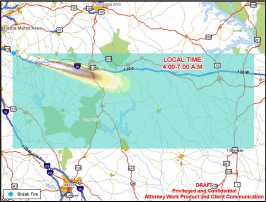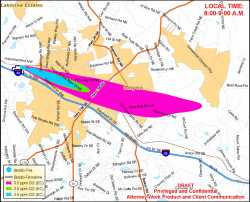BioLab Fire
The accident
On May 25, 2004, a warehouse containing pool chemicals at the BioLab, Inc. facility in Conyers, GA, experienced a fire. This caused the evacuation of an area nearly 1 mile downwind of the facility and the shutdown of I-20 for several hours. The fire was extinguished by the morning of May 26, 2004. A full accident report prepared for the US EPA is available here.
EnviroComp's Role
We were asked to collect all available data, simulate the multi-hour plume generated by the fire, and calculate the ground level impact of chemicals downwind. Our combustion expert calculated the time-varying emission of chemicals as products of combustion. It was clear from satellite images (Figure 1) that a large fraction of the hot plume ("upper plume") moved above the planetary boundary layer (PBL) and continued to travel horizontally as a narrow plume trapped aloft. A limited fraction of the plume ("lower plume") remained inside the PBL and caused a ground level concentration impact. We used the CALPUFF modeling system to simulate both plumes.
The Chlorine (Cl2) simulation of the upper plume is presented in Figure 2 and matches quite well the satellite images. An animation is presented in Video 1.
The Cl2 simulation of the lower plume is depicted in Figure 3 as maximum pointwise hourly concentration during the entire 33-hour CALPUFF run. An animation of the lower plume is presented in Video 2. Our simulated concentrations match reasonably well with the air quality measurements collected during the incident.
Our work was accepted by counsel for both claimants and defendants as being determinative of areas of impact and intensity of impact within those areas, which was useful to resolving the entire matter.




